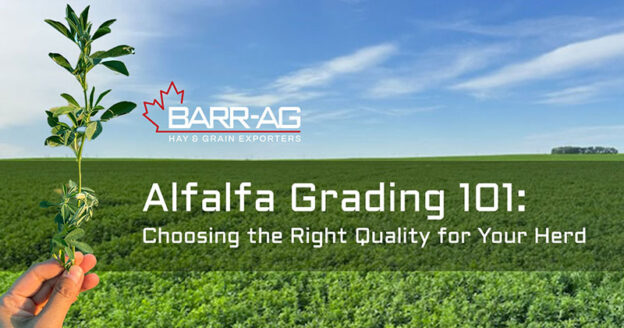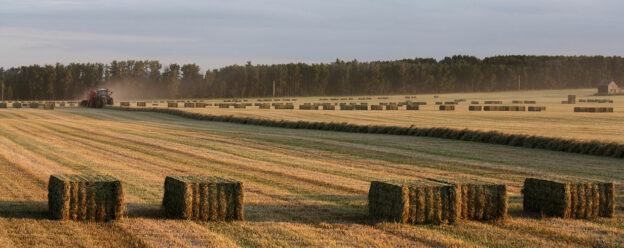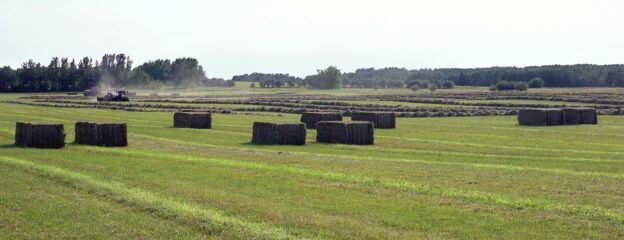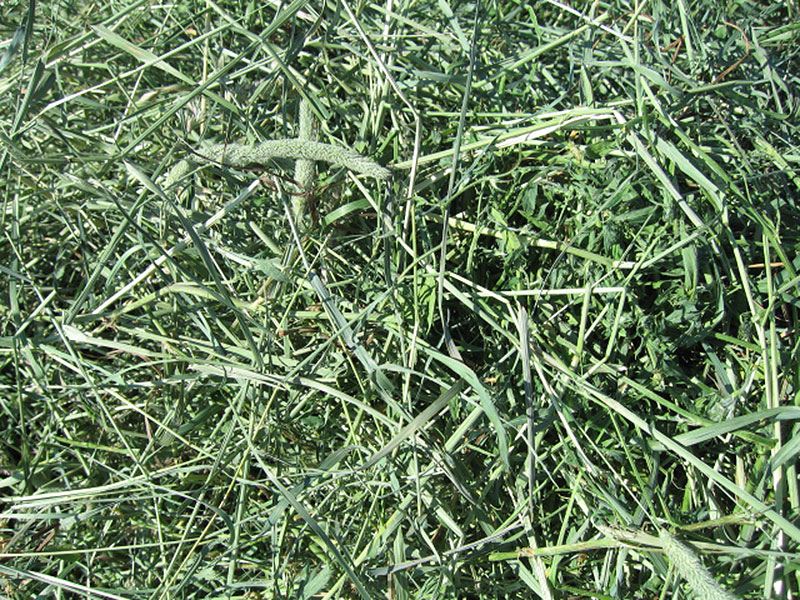Alfalfa is one of the most valuable forages in livestock nutrition, known for its high protein, digestibility, and energy content. Whether you’re managing a high-producing dairy herd, raising young livestock, or feeding performance horses, the grade of alfalfa you choose has a direct impact on animal performance, health, and operational efficiency.
At Barr-Ag, we grow and supply premium non-GMO alfalfa from Alberta, using sustainable farming practices. Our alfalfa is tested regularly through internationally recognized laboratories. This gives our customers confidence in the consistency, safety, and nutritional value of every bale.
What Are Alfalfa Grades?
Alfalfa is graded based on nutritional content and physical quality, with a focus on the factors that affect livestock intake and digestion. The most common grading system used in North America is based on the Relative Feed Value (RFV), which estimates the intake potential and digestibility of the forage.
RFV Formula Used by Labs
RFV = [120 / (NDF %DM)] × [88.9 – (0.779 x ADF %DM)]
Where:
- ADF (Acid Detergent Fiber) affects digestibility
- NDF (Neutral Detergent Fiber) affects intake
Alfalfa Grade Classifications
RFV is used to classify alfalfa into quality grades. These help buyers determine the right product for their livestock’s needs.
| Grade | RFV Range | Typical Use |
| Supreme | > 180 | High-producing dairy cows |
| Premium | 151–180 | Dairy, performance horses |
| Good | 125–150 | Dairy heifers, beef stock |
| Fair | 100–124 | Beef cows, maintenance feeding |
| Utility | < 100 | Dry cows, low nutrient requirements |
Factors That Influence Alfalfa Quality
Several factors can affect the final grade of alfalfa:
- Maturity at Harvest
Earlier cuts have higher protein and lower fiber. As alfalfa matures, fiber increases and digestibility decreases.
- Leaf-to-Stem Ratio
Leaves contain most of the nutrients. A higher leaf content indicates better quality.
- Moisture Content
Ideal baling moisture is 12 to 15 percent. Hay that is too wet can mold and generate heat. If too dry, leaf shatter becomes a concern.
- Color and Aroma
Bright green, clean-smelling alfalfa indicates freshness. Discoloration or musty odors signal quality loss.
- Foreign Material
Weeds, dust, and debris reduce feeding value and safety.
Why Alfalfa Grade Matters
Choosing the right grade of alfalfa ensures:
- Optimal animal health and productivity
- Reduced need for supplemental feed
- Lower veterinary and feed costs
- Less waste and improved feed efficiency
Feeding high-quality forage supports better weight gain and milk production in cattle, while providing the energy and performance benefits needed for horses. Across all livestock, quality forage contributes to long-term health and productivity.
Barr-Ag’s Commitment to Forage Quality
At Barr-Ag, we don’t just grow alfalfa. We carefully grade, test, and package every lot to meet the needs of diverse livestock operations across North America and around the world. We follow a meticulous quality control process from field to shipment.
Whether you’re raising cattle, caring for horses, or supplying feed, you can count on us for clean, consistent, and nutritionally reliable forage.
Choose Premium Alfalfa with Confidence
If you’re ready to elevate your feed program, Barr-Ag is here to help. Our team can assist in finding the ideal alfalfa grade for your animal’s nutritional needs. For specific dietary requirements, we recommend consulting your veterinarian.
Contact us today to learn more.









